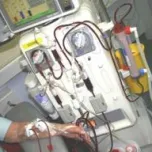A carbon footprinting study published in Hemodialysis International this month comparing in-centre and home haemodialysis highlights that the frequency of treatments has a big impact on carbon emissions. For clinical reasons, more frequent dialysis is increasingly used, so preventing a growth in emissions will require the development of lower carbon technologies, sustainable procurement policies and efficient waste management.
Work carried out by Dr Andrew Connor (Green Nephrology Fellow 2009-2010) in collaboration with Dr Robert Lillywhite and Professor Matthew Cooke from Warwick University is the first to compare the carbon emissions associated with different modalities of haemodialysis.
Provision of end stage renal failure services including in-centre haemodialysis uses 2% of the overall NHS budget and generates high green house gas emissions from disposable equipment use. The majority of people who require dialysis receive it by traveling to hospital thrice weekly and currently only 2% of people in the UK who require dialysis can do so at home. Home based treatments offer a number of advantages and in 2002 NICE recommended that it be offered to all suitable people (estimated at 10-15% of the UK dialysis population). It reduces frequent travel, allows greater flexibility of treatment times and increases self-care with users often scoring higher in quality of life and empowerment surveys. Additionally, home treatments are typically performed more frequently resulting in greater removal of waste products and fluid, permitting relaxation of otherwise strict dietary and fluid restrictions. Home dialysis is also cheaper than in-centre dialysis over time and maximises in-centre resources for those unsuitable for home based treatment. For all these reasons and given that home dialysis is at least as effective, if not better than in-centre treatment, home dialysis should increase within the UK.
In this context it is vital that carbon modeling data is available to inform clinical service redesign. This is the first such study. It compares green house gas emissions for typical in-centre versus home dialysis treatments and has demonstrated a divergence between cost and carbon emissions; with home based therapies producing greater emissions that increase with the frequency of treatments, through greater use and disposal of equipment. This high contribution of procurement to the renal service carbon footprint was highlighted in the group's first study of a renal service and has led to the Centre for Sustainable Healthcare establishing the Renal Sustainable Procurement Group working with NHS regions and the Department of Health to introduce sustainable criteria into purchasing tenders. Additionally by using a low carbon care approach to lean clinical processes such as dialysis renal services in Cornwall and Fife have reduced cost and carbon emissions through efficient waste management streams.
Additionally the authors found that newer dialysis technologies like the NxStage System One machine, was associated with lower emissions than either in-centre or home dialysis using standard machines, mostly through reduced energy use and minimal installation. However the reduced efficiency of this system would suggest that this benefit may be offset in part by the need to exceed standard settings to achieve equivalent levels of dialysis.
Theoretical analysis was made in the paper to account for the practice of dialyzer re-use and adjustments for time. While these provide an interesting model of carbon emissions under different conditions, neither situation is likely to occur at present within the UK for clinical reasons.
The clinical and economic case detailed above will drive an increase in self-care for this patient group and consequently home based dialysis. Connor et al are the first to illustrate the increased greenhouse gas emissions that may be associated with this. Considering the service as a whole however, some of this increase might be offset by establishing in-centre self-care areas where people perform dialysis themselves reducing the higher emissions associated with staff travel, individual water treatment, home set up and individual machine use. At present treatments such as NxStage System One could also help to address this however they are relatively expensive and inefficient compared to standard home treatments. The findings of Connor et al highlight the need for continued innovation in this area to inform service redesign and highlight the ongoing need to incorporate sustainable procurement policies and efficient waste management systems into the NHS as standard.

Please log in or sign up to comment.